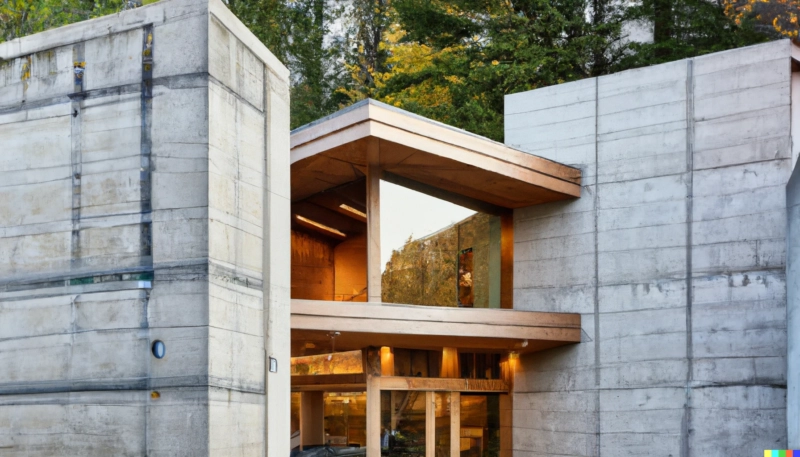AI-Generated Designs Are Letting Architects Unlock New Forms of Creativity. How Should They Deploy It?
Generative AI in architecture is already evolving architectural workflows, and the creative results are proving themselves in real time. Tools like ChatGPT and Midjourney are acting as a dynamic platform for concept design and visual brainstorming, enabling the synthesis of diverse architectural styles and historical influences into fresh and innovative ideas. There’s still a lot of misunderstanding around the power and role of AI-generated designs in architecture, though, with fear that this tech will phase out the value of expert architectural designers. Where should architects start leveraging AI in their workflows, if at all?
Some architects are realizing that AI-generated designs aren’t here to replace their work, but rather enhance it and add new layers of creativity. London-based architectural designer Tim Fu, for instance, is experimenting with the right balance of using Midjourney to produce stunning design results for brainstorming user’s artistry. Notably, architects are harnessing Midjourney’s power to explore abstract designs, merging cinematic worlds with real architectural structures. However, the practical implementation of AI-inspired designs remains a challenging endeavor, with some architects viewing them merely as conceptual visions. Despite these hurdles, firms like Coorlas Architecture are successfully integrating AI inspirations into real-world structures, such as a planned open-air pavilion in Chicago featuring AI-inspired, 3D-printed adobe arches. As the technology evolves, many in the field believe that AI’s influence could soon prompt significant changes across the real estate sector.

Mark Nichols, owner of and architect at MNichols Design and a strategic architectural advisor at Real Estate Bees, as well as Jeff Akerman, principal at RISE Architecture and a strategic architecture advisor at HouseCashin.com, reflect on the fast-moving adoption of AI-generated designs in architecture, and offer some strategies for how these tools can lay new foundations for creativity.
Mark’s Thoughts
“Artificial intelligence, especially image aggregation and generation AI, like Midjourney or Adobe’s Firefly or DALL-E, are creating an undeniable buzz in many industries, but especially architecture and design. Currently AI excels at aiding the concept design and visual brainstorming phase of a project. Beyond that phase, it still requires the expertise and training of an architect to synthesize that concept into a workable set of drawings that incorporates the client’s needs, programmatic considerations, zoning and building code regulations, construction constraints, and consultant input.
Now that’s not to undersell the importance of concept design and visual brainstorming. What AI can do right now is frankly incredible and almost taken for granted because of all the options that are out there. It produces compelling and beautiful images that can be crafted to fit specific prompts, but it can also explore blending of architectural styles and provide a playfully iterative process for honing new hybrid approaches to architecture.
For instance, let’s say there is a client that likes the exposed structure and layered masking of traditional Japanese architecture, but also loves the clean and contemporary detailing of Olson Kundig, one of the world’s leading residential architecture firms. Well, a prompt can be crafted that blends these two styles, and within seconds we get a glimpse into a new architecture that bridges hundreds of years of architectural history.
AI produces amazing concept imagery, but more importantly, provides opportunity to quickly combine different styles and take elements from various architects and other past successful designs and breathe the visual life into something new and unexpected. I’ve been enjoying working with this new technology and I’m excited to see where it goes next.”
Jeff’s Thoughts
“One of the things that we see from AI, specifically when it comes to facade work and other items that we use AI for, for generating conceptual concepts within designs and layouts, we find that the information coming out of it is pulled together from multiple different sources. So it searches online for information and then you get this kind of mosaic of information, which gives us a very unique approach to design. So one of the things that we started using it for is that if we want to play with a different facade idea, we’ll actually throw it into an AI and spit out a bunch of information on many different items that the building could potentially look like.
One of the things we actually used AI for recently is we were working on a competition. We threw the ideas that we had in mind for the AI and spit out a very interesting rendering for what it could potentially look like.
I want to take a moment to talk about what I think AI should be doing and what potentially it could be doing in the future, is that we do in architecture firms, we do a lot of construction documents where we do an analysis on the building at the back end. I would love AI to be able to do its own analysis of the building to make sure that the details are buildable and actually all of the items that we were thinking of actually went through them, paid attention to those details because I think the future is that AI can really do our construction documents for us, we’ll do the design, we’ll pay attention to those designs, but imagine spitting a design set into an AI system and then within 15, 20 minutes, you have a full set of construction documents. I mean, absolutely amazing, amazing feat by that.”
Article written by Daniel Litwin.








